Scarborough, Richmond and Helmsley Castles: Three of Yorkshire's Finest
by Dawn Copeman
Do you know where one of the oldest cricket pitches in England was laid? Do you know which medieval stronghold was first tested in battle in the Civil War? Or where King Arthur sleeps? If not, then you need to visit these three castles in North Yorkshire.
Scarborough Castle
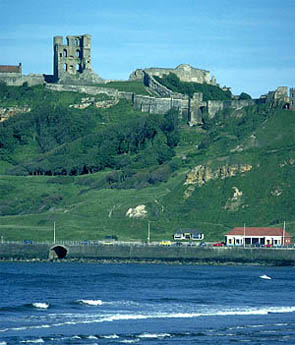 Scarborough Castle sits on top of the cliffs above the popular seaside town of the same name. Archaeological excavations have proven that there has been a building on this triangular plot of land since the Bronze Age and that a Roman signal station was built here in approximately 370 AD, the remains of which can be seen today. But it was only in 1066 with the arrival of William of Normandy that things began to develop, not only for this plot of cliff top land but for the castle as well.
Scarborough Castle sits on top of the cliffs above the popular seaside town of the same name. Archaeological excavations have proven that there has been a building on this triangular plot of land since the Bronze Age and that a Roman signal station was built here in approximately 370 AD, the remains of which can be seen today. But it was only in 1066 with the arrival of William of Normandy that things began to develop, not only for this plot of cliff top land but for the castle as well.
In 1066 a monastery and its cliff-top chapel at Scarborough were destroyed by the invading Norwegians under Harald Hardrada. Thus cleared, the land made an ideal spot for a new castle to defend the kingdom against the Scots in the north and the French across the sea. In fact, Scarborough Castle was to play such an important role in the defence of the country that it is a source of some puzzlement to scholars as to why no castle had been previously built on this strategic site.
The first stage of the castle was built in approximately 1140 AD by William le Gros, but over the years it was added to by, amongst others, King John, King Henry II, King Henry III, and King Edward III. During this time huge curtain walls, a barbican, a keep and a forebuilding were added. Scarborough was a heavily fortified castle, and as soon as a new technology in defending castles was invented, the King of the day saw to it that Scarborough had it.
Yet the ownership of Scarborough castle kept shifting between the landed gentry (William le Gros was the Earl of Albemarle) and the Crown. In 1154 Henry II demanded the ownership of all properties built on royal land, of which Scarborough was apparently one. In 1624 James I sold the castle to the Earl of Holderness. It was then bought back again by Charles II in 1662.
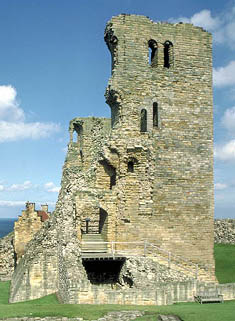 Scarborough has seen plenty of action. It was first besieged in 1312, when it was the residence or refuge of Piers Gaveston, a favourite -- or some say, lover -- of Edward II. The castle was undamaged, but Piers ran out of food and was captured. He was subsequently beheaded by the Earl of Warwick despite having been promised safe passage to London. In 1318, Scarborough was attacked for the first time by the Scots, and the castle continued to defend England from the French and the Scots even into the late 15th and early 16th centuries.
Scarborough has seen plenty of action. It was first besieged in 1312, when it was the residence or refuge of Piers Gaveston, a favourite -- or some say, lover -- of Edward II. The castle was undamaged, but Piers ran out of food and was captured. He was subsequently beheaded by the Earl of Warwick despite having been promised safe passage to London. In 1318, Scarborough was attacked for the first time by the Scots, and the castle continued to defend England from the French and the Scots even into the late 15th and early 16th centuries.
The castle remained impregnable until the English Civil War, when it was besieged by the Parliamentarians and suffered from heavy cannon fire that severely damaged the Keep and destroyed the western wall. Thereafter, Scarborough was used as a prison until a military barracks block was built within it in the 18th century. These barracks were destroyed when the castle suffered damage for the second and last time, on 16 December 1914, when two German warships bombarded the castle. Luckily the Germans did not know it was still in active use in the Second World War, or it might have been attacked again. This time it was the home to a listening post.
Visitors today can see the remains of the Roman signal station, the chapel built in 1000 AD and destroyed by Hardrada's men, the fireplaces on the first and second floor of the remains of the keep, the surviving 85-foot curtain walls, and the remains of the highly decorated chapel built by William le Gros at the beginning of the castle's life. The views from the viewing platforms built around the walls are spectacular. And after all this, you can enjoy a more peaceful, English pastime and watch or play a game of cricket on what is thought to be one of England's oldest cricket pitches, founded in 1849.
Richmond Castle
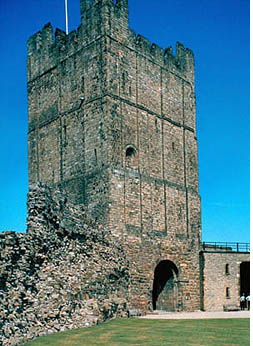 Richmond castle is an oddity amongst English castles for three reasons: it was built entirely of stone with no preliminary earthworks; it has two keeps; and, finally, there was no real reason to build it. Prior to 1071 there had not been a castle, or any other type of building, on this site high above the river Swale. The only reason that there is a castle at Richmond -- or riche Monte (strong hill) as it was called in Norman French -- was because of a huge overreaction to the events of 1069.
Richmond castle is an oddity amongst English castles for three reasons: it was built entirely of stone with no preliminary earthworks; it has two keeps; and, finally, there was no real reason to build it. Prior to 1071 there had not been a castle, or any other type of building, on this site high above the river Swale. The only reason that there is a castle at Richmond -- or riche Monte (strong hill) as it was called in Norman French -- was because of a huge overreaction to the events of 1069.
In 1069 English rebels still opposed to Norman rule attacked York and killed many Normans stationed there. To ensure that this would not happen again, King William attacked and destroyed a large part of the rebellious north. Then in 1071, when he was happy that the rebellion had been suppressed, it is thought that William spent Christmas in the area and divided up the lands between his Norman supporters.
Alan the Red of Brittany was awarded with the area of Richmond, and there he built his castle. Uniquely, he built it entirely of stone, with no earthworks first. In the 11th century a 'French Keep' was built. A French Keep combined accommodation and security in the one building, common in France but unheard of in England. This French Keep, called Scolland's Hall, still stands today, as part of the Gold Hole Tower. Then in the 12th century a taller, more traditional English Keep was added, which is today one of the best preserved Keeps in the land.
The castle was protected by steep cliffs and thick curtain walls, yet never really needed any protection. When Scarborough was being attacked in the 14th century it did seem as though Richmond might be used, but apart from the outer wall being extended to enable the townsfolk to live and work safely within the confines of the castle, nothing happened. Politically, however, it was heavily involved in the history of England. During the Hundred Years' War, the castle, belonging as it did to the Dukedom of Brittany, was continuously being taken by the English King only to be given back again as soon as peace resumed. The castle first passed into English ownership when John of Gaunt became the Earl of Richmond in 1342. Gaunt held onto it for 30 years, during which time he was heavily involved in the French war at Calais as well as with fighting the invading Scots. A later Earl of Richmond became King Henry VII, and thus Richmond became a royal palace.
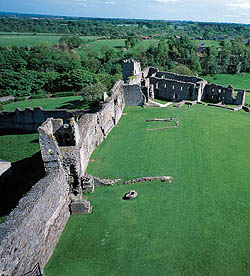 Richmond was never involved in the War of the Roses or the English Civil War, because there really was no need for a castle there and therefore no reason to want to take it. It was, however, used as a prison from time to time, and has held King William the Lion of Scotland and King Charles I. However, despite the lack of cannon fire and siege machines, the castle is still in a bad state today, as it fell out of use and started to deteriorate in the 16th century.
Richmond was never involved in the War of the Roses or the English Civil War, because there really was no need for a castle there and therefore no reason to want to take it. It was, however, used as a prison from time to time, and has held King William the Lion of Scotland and King Charles I. However, despite the lack of cannon fire and siege machines, the castle is still in a bad state today, as it fell out of use and started to deteriorate in the 16th century.
Ironically for a castle that served no great military purpose when it was built, Richmond Castle served as a military headquarters in the 19th century, as a prison for conscientious objectors in the First World War, and as the headquarters for General Baden-Powell's Territorial Army Division in the Second World War. Once again, no damage was sustained -- which means there is plenty left for us to explore. We can see the whole of the 12th century keep, the remains of Scolland's Hall, the Gold Hole tower, and the Robin Hood Tower. You can also see some of the artefacts that have been uncovered at Richmond during various archaeological digs and learn about life in the castle in the exhibition 'Castle, Commerce and Conscience.' Or maybe you'd like to look for Excalibur!
For legend has it that deep under the French Keep is a cavern, and that in this cavern sleeps King Arthur and the Knights of the Round Table. Legend also has it that a young lad called Potter or Peter Thompson found the entrance to this cavern via a tunnel at the bottom of the hill. After walking through this tunnel he found an elaborate crypt with carved tombs on which slept King Arthur and his Knights. He apparently saw Excalibur and a horn lying on a tomb and began to lift Excalibur. As he lifted the sword, the sleeping knights began to wake up. Terrified, he dropped the sword and fled, and couldn't ever find his way back to the cavern again. Maybe you'll feel like having a look yourself? I have but to no avail.
Helmsley Castle
There are no prizes for guessing that Helmsley Castle was the one first tested in the Civil War. Walter L'Espec, who owned much of the surrounding Rye Valley and who incidentally provided the land for Rievaulx Abbey, began building the castle around 1120. He erected a timber and earth motte and bailey castle and cut two deep, defensive ditches out of the surrounding rock. On his death the castle was passed on to the de Roos family, who held it until the 15th century. It was briefly owned by Richard III, but came back to the de Roos family after Richard died at Bosworth Field. Over the centuries the de Roos family rebuilt the castle in stone and added strong curtain walls with round watch towers and a gatehouse. They also added a barbican, two towers within the walls and an accommodation hall, which linked up to the wall.
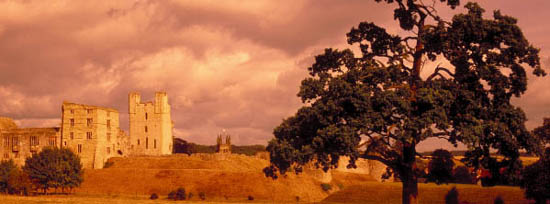
The castle was strong and it was lucky. Despite its proximity to York and Malton, it was not involved in the War of the Roses, nor did it suffer any sieges until the Civil War. This long era of piece is echoed in the castle's design, for during the 1560's a large portion of the castle was converted into an Elizabethan manor house by the Edward Manners, Earl of Rutland, who then owned it.
During the Civil War, the castle was besieged for three months by the Roundheads. When the Royalists surrendered due to lack of food, the Parliamentarians, led by Sir Thomas Fairfax, destroyed much of the castle's defences and sliced the keep in half with cannon fire. Fairfax was careful not to destroy the manor house, which was fortunate as his daughter later married the owner of Helmsley Castle, the Duke of Buckingham! The house remained occupied until the 18th century.
Today visitors can see the remaining half of the keep, admire the Elizabethan mansion (complete with a partially restored room), and walk around the impressive ditches. There is an audio tour to guide you around the site, and in the visitor center you can see many of the artefacts that have been excavated by English Heritage, which maintains all three castles.
More Information:
We regret that we no longer have the resources to maintain up-to-date links and/or hours and pricing details for the various sites and attractions listed on this website. For more information about the location(s) listed above, please use your favorite search engine or visit Wikipedia.
Dawn Copeman is a freelance writer and commercial writer who has had more than 100 articles published on travel, history, cookery, health and writing. She currently lives in Lincolnshire, where she is
working on her first fiction book. She started her career as a freelance
writer in 2004 and has been a contributing editor for several publications, including TimeTravel-Britain.com and Writing-World.com .
Article © 2005 Dawn Copeman
Photos © Britainonview.com
|
